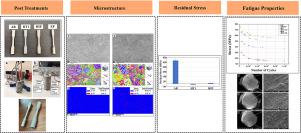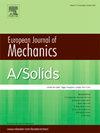Effect of post-treatments on the microstructural and fatigue properties of Ti6Al4V-ELI alloy fabricated by laser powder bed fusion method
IF 4.2
2区 工程技术
Q1 MECHANICS
引用次数: 0
Abstract
The Laser Powder Bed Fusion method is a modern production technology that allows products with complex geometry to be produced. In parts produced with this method, surface roughness and defects such as voids and unmelted powders in the internal structure negatively affect the fatigue life of the part. Post-treatments are often needed to optimize the microstructure and obtain the required fatigue properties. This study examined how the mechanical properties were affected by heat treatment (HT) conducted both below and above the transformation temperature. The effects of HIP and electropolishing (EP) processes applied to Ti6Al4V-ELI alloys on fatigue behavior were examined. Residual stress values of untreated and post-treated samples were measured, and the results were interpreted. A significant decrease of approximately 10 times in the surface roughness values of fatigue samples was detected with the electropolishing process. The fatigue limit of the as-built (AB) samples was 150 MPa. After applying HT1+EP and HIP+EP post-treatments to the AB samples, the fatigue limit increased by approximately 3.6 and 3.9 times, respectively, compared to the untreated AB condition. Considering the fact that the fatigue limit values between the two groups are not very different and the high cost of the HIP process, it was evaluated that the HT1+EP process may be a more suitable post-treatment in terms of fatigue performance of additively manufactured parts.

后处理对激光粉末床熔合Ti6Al4V-ELI合金组织和疲劳性能的影响
激光粉末床熔融方法是一种现代生产技术,可以生产复杂几何形状的产品。在用这种方法生产的零件中,表面粗糙度和内部结构中的空洞和未熔化粉末等缺陷会对零件的疲劳寿命产生负面影响。通常需要后处理来优化组织并获得所需的疲劳性能。本研究考察了在β转变温度以下和高于β转变温度的热处理(HT)对合金力学性能的影响。研究了HIP和EP工艺对Ti6Al4V-ELI合金疲劳性能的影响。测量了未处理和后处理样品的残余应力值,并对结果进行了解释。经电抛光处理后,疲劳试样表面粗糙度值显著降低约10倍。试样的疲劳极限为150 MPa。对AB试样进行HT1+EP和HIP+EP后处理后,与未处理的AB相比,疲劳极限分别提高了约3.6倍和3.9倍。考虑到两组工艺的疲劳极限值差异不大,且HIP工艺成本较高,从增材制造件的疲劳性能来看,HT1+EP工艺可能是一种更合适的后处理工艺。
本文章由计算机程序翻译,如有差异,请以英文原文为准。
求助全文
约1分钟内获得全文
求助全文
来源期刊
CiteScore
7.00
自引率
7.30%
发文量
275
审稿时长
48 days
期刊介绍:
The European Journal of Mechanics endash; A/Solids continues to publish articles in English in all areas of Solid Mechanics from the physical and mathematical basis to materials engineering, technological applications and methods of modern computational mechanics, both pure and applied research.

 求助内容:
求助内容: 应助结果提醒方式:
应助结果提醒方式:


